In bilingual education, students are taught in two languages. It is distinct from learning a second language as a subject because both languages are used for instruction in different content areas like math, science, and history. The time spent in each language depends on the model. For example, some models focus on providing education in both languages throughout a student's entire education while others gradually transition to education in only one language. The ultimate goal of bilingual education is fluency and literacy in both languages through a variety of strategies such as translanguaging and recasting.
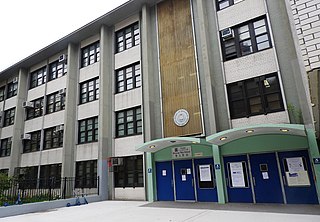
PS 184M Shuang Wen School, a public school in New York City also known as PS 184, is a Dual Language elementary and middle school located in Lower Manhattan. The school teaches students from Pre-Kindergarten to 8th grade. It is a part of the New York City Department of Education and located in Manhattan District 1 which includes the Lower East Side and East Village. A major $1.7 million renovation of the school playground and soccer field was completed in 2019 by the Trust for Public Land and DEP. In the elementary school, the school teaches in Traditional Chinese and utilizes the zhuyin phonetic system popular in Taiwan. During the typical school day, one day is taught in English and other day is in Mandarin. As a Dual Language school, classes in both languages are a mandatory part of the curriculum.

Language immersion, or simply immersion, is a technique used in bilingual language education in which two languages are used for instruction in a variety of topics, including math, science, or social studies. The languages used for instruction are referred to as the L1 and the L2 for each student, with L1 being the student's native language and L2 being the second language to be acquired through immersion programs and techniques. There are different types of language immersion that depend on the age of the students, the classtime spent in L2, the subjects that are taught, and the level of participation by the speakers of L1.

Chicago Public Schools (CPS), officially classified as City of Chicago School District #299 for funding and districting reasons, in Chicago, Illinois, is the fourth-largest school district in the United States, after New York, Los Angeles, and Miami-Dade County. For the 2020–21 school year, CPS reported overseeing 638 schools, including 476 elementary schools and 162 high schools; of which 513 were district-run, 115 were charter schools, 9 were contract schools and 1 was a SAFE school. The district serves 340,658 students. Chicago Public School students attend a particular school based on their area of residence, except for charter, magnet, and selective enrollment schools.

Shanghai French School is a private, international school in Shanghai, China, with one campus in the Qingpu District and one campus in Yangpu District.

Prince George's County Public Schools (PGCPS) is a public school district that serves Prince George's County, Maryland. During the 2023-2024 academic year, the district enrolls 133,000 students and operates over 200 schools. PGCPS is the second-largest school district in Maryland, the third-largest district in the Washington-Baltimore metropolitan area, the 18th-largest in the United States, and the nation's largest school district with a majority-black student population.
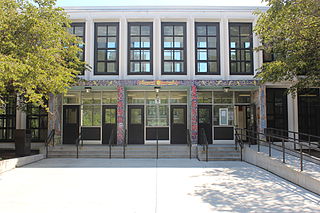
Kenwood Academy is a comprehensive public 4–year high school and magnet middle school located in the Hyde Park–Kenwood neighborhood on the south side of Chicago, Illinois, United States. Operated by the Chicago Public Schools (CPS) district, Kenwood opened in temporary quarters in 1966 and in its permanent building in 1969. Kenwood limits acceptance of high school students to those living in Hyde Park: from Lake Michigan to Cottage Grove Avenue east to west, and 47th to the Midway Plaisance north to south. Kenwood was recognized as a School of Distinction for its academic achievement and a Model School by the International Center for Leadership in Education in 2004. In addition to being a local high school, Kenwood has a magnet program that accepts students entering into 7th grade who pass a rigorous admissions test. The magnet program accepts students citywide using a random lottery with a standing of 6 or higher in both reading and math.
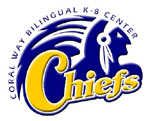
The Coral Way Bilingual K-8 Center, built as Coral Way Elementary School in 1936, is a K-8 school located in Miami, Florida, United States (US). The school was a pioneer of bilingual education in 1963, when it began teaching through the mediums of English and Spanish with two groups of students. In 2004, the school expanded to includes grades 7 and 8.
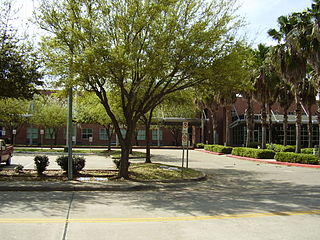
The Rice School is a K-8 school in Houston, Texas. Rice is a part of the Houston Independent School District (HISD).
Plainview Independent School District is a public school district based in Plainview, Texas (USA).
Dual language is a form of education in which students are taught literacy and content in two languages. Most dual language programs in the United States teach in English and Spanish, but programs increasingly use a partner language other than Spanish, such as Arabic, Chinese, French, Hawaiian, Japanese, or Korean. Dual language programs use the partner language for at least half of the instructional day in the elementary years.
The English Language Acquisition, Language Enhancement, and Academic Achievement Act - formerly known as the Bilingual Education Act - is a federal grant program described in Title III Part A of the federal Elementary and Secondary Education Act (ESEA), which was reauthorized as the No Child Left Behind Act in 2002 and again as the Every Student Succeeds Act in 2015. This section is specifically targeted to benefit Limited English Proficient (LEP) children and immigrant youth. The statute states that LEP students must not only attain English proficiency but simultaneously meet the same academic standards as their English-speaking peers in all content areas. Federal funding is provided to assist State Education Agencies (SEAs) and Local Education Agencies (LEAs) in meeting these requirements. In 2011, ESEA Title III awards were granted to 56 SEAs and the average award given to an individual SEA was $12,158,046.
Benito Juarez Community Academy,, is a public 4–year high school in the Pilsen neighborhood on the west side of Chicago, Illinois, United States. Juarez is named for Mexican president Benito Pablo Juárez García. The school is a part of the Chicago Public Schools (CPS) district. As of 2014 it is the largest high school in Pilsen. It was designed by architect Pedro Ramírez Vázquez.
Cupertino Language Immersion Program (CLIP) is an alternative K-8 education program located at John Muir Elementary School (K-5) and Joaquin Miller Middle School (6-8) in the Cupertino Union School District (CUSD). CLIP is the oldest public Mandarin Immersion program in California and the second oldest in the country.

A.N. Pritzker school is located in the Wicker Park neighborhood in Chicago, Illinois. Pritzker School serves grades K-8 with its neighborhood magnet-cluster school focused on fine and performing arts and a Regional Gifted Center. Pritzker also offers a Pre-K for all program. The school is part of the Chicago Public Schools, CPS, system. The students and its mascot are referred to as the Wildcats.

Miami-Dade County Public Schools (M-DCPS) is the public school district serving Miami-Dade County in the U.S. state of Florida. Founded in 1885, it is the largest school district in Florida, the largest in the Southeastern United States, and the third-largest in the United States with a student enrollment of 356,589 as of August 30, 2021.

William H. Wharton K-8 Dual Language Academy, formerly William Wharton Elementary School, is a public school in the Neartown area of Houston, Texas and part of the Houston Independent School District. Also known as the Wharton Dual Language Academy, the school serves gifted and talented students in the Language Magnet program from Pre-K through 8th grade.
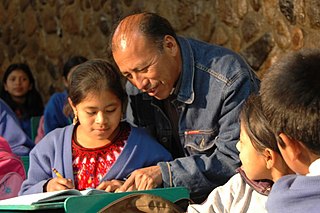
Intercultural bilingual education in Guatemala was begun as part of a 20th-century educational reform effort intended to promote the country's cultural diversity. The programs merge Mayan language and culture with Spanish language and Ladino culture, a shift from the assimilation policy of educational programs promoting Spanish literacy which reduce the use of indigenous languages. During the 20th century, education reform evolved from castilianization and the 1965 Bilingual Castilianization Program to the 1980 National Bilingual Education Project. Each program aimed to increase Spanish fluency. In 1985, the Constitution legalized bilingual education and the Ministry of Education formed the Programa Nacional de Educación Bilingüe (PRONEBI). PRONEBI developed from the 1980–1984 National Bilingual Education Project, and aimed to provide bilingual education for rural indigenous children.

Natchaug Elementary School is a public elementary school in Willimantic, Connecticut, United States. The school opened in 1865 and is located at the junction of Milk Street and Jackson Street in downtown Willimantic. It is one of four elementary schools in the Windham Public School system. Natchaug is accredited by the New England Association of Schools and Colleges. The name "Natchaug" comes from the Native American Nipmuc word meaning "land between the rivers." The school colors are bright green and blue.














